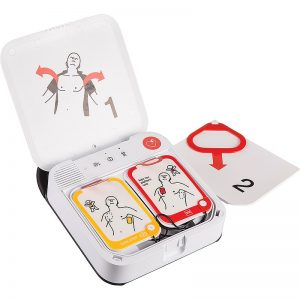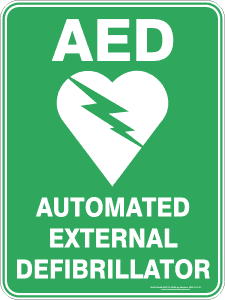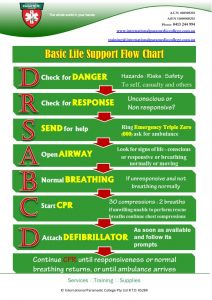What Is an AED?
 An AED, or automated external defibrillator, are an easy-to-use small electronic devices that can be used by anyone to deliver a shock to a patients’ chest in Sudden Cardiac Arrest (SCA). It can diagnose and treat life-threatening cardiac arrhythmias called Ventricular Fibrillation VF or Ventricular Tachycardia VT. Simply put, the AED does not tell you if a patient is alive or dead. It does not tell you if they are well or unwell. It simply looks for a shockable rhythm and if it sees a shockable rhythm, then it will deliver a shock, usually automatically or by the user pushing a button when prompted.
An AED, or automated external defibrillator, are an easy-to-use small electronic devices that can be used by anyone to deliver a shock to a patients’ chest in Sudden Cardiac Arrest (SCA). It can diagnose and treat life-threatening cardiac arrhythmias called Ventricular Fibrillation VF or Ventricular Tachycardia VT. Simply put, the AED does not tell you if a patient is alive or dead. It does not tell you if they are well or unwell. It simply looks for a shockable rhythm and if it sees a shockable rhythm, then it will deliver a shock, usually automatically or by the user pushing a button when prompted.
The range of AED’s available are designed to allow minimally trained people to provide lifesaving defibrillation (electric shock to the heart) to victims of sudden cardiac arrest when they are in a shockable rhythm. Information on success rates and the practical use of an AED is available here.
Why do you need an AED?
The Australian Resuscitation Council (ARC) who set the guidelines for training first responders and the general public in Australia say that for every minute defibrillation is delayed there is a 10% reduction in your chance of survival from sudden cardiac arrest. So, it is better that AED’s are readily available and can be applied and used by the general public as delay in waiting for an ambulance response will decrease the chance of survival. We have put together an article you can read outlining 7 reasons you should buy an AED.
How Does An AED Work?
An AED is programmed to prompt you what to do in SCA. Different companies products can seem a bit daunting, but they all operate similarly. Pads must adhere to the chest as in the location indicated on the pads, and follow the prompts from the AED to deliver a shock. Defib machines may have voice prompts to guide you to preform CPR between shocks.
The AED is designed to analyse the electrical activity of the heart via the pads on the chest to determine if a shock is the correct treatment. Some rhythms do not require a shock, and so the AED will say something like “no shock advised”. This does not mean the person is ok or the machine is broken. Only certain rhythms can be treated by and respond to the electric shock or defibrillation as it is called. If a “shockable” rhythm is present, the machine will charge up and deliver a shock automatically, and prompt you to stand clear of the patient while the shock is delivered. Or it may ask you to press a button to deliver the shock and prompt you to stand clear of the patient for your safety.
Some AED units also help monitor the effectiveness of your CPR. An AED is designed to guide you through the resuscitation process with voice prompts or pictures. All you have to do is be calm enough to use your common sense to follow the prompts. The shock delivered briefly stops all electrical activity in the heart. This brief break from the previous electrical chaos can be enough for the heart to restart or reset itself to a normal rhythm.
Not all victims of SCA can be saved, but early defibrillation is the key to improved survivability of sudden cardiac arrest. This simple use of an AED can make all the difference.
This is the standard National Sign for AED’s in Australia Download A Free AED Sign Click Here
Where is AED’s located?
Where is AED’s located?
You need to look around you and I challenge you to notice when you see an AED as you never know when one may be needed. Next time you are in your shopping centre or out in your community, have a look around for the sign indicating an AED.
How can I compare AED’s?
Contact us, and we can provide you with an AED comparison chart that compares all the major brands of AED’s and the ongoing costs associated with ownership.
Where can I buy a defib?
International Paramedic College can provide you with an AED and training support in how to use them. We stock most brands and can advise you on what AED will best suit your needs and budget. We have a range of great value packages.
How much is an AED?
Prices range from about around $1800 to $3000. Contact us for prices or just for some great advice about what sort of AED you should buy and why.
How much of a shock does a defibrillator give?
The shock delivered by an AED to an Adult patient can vary from around 180 Joules to 360 joules. The best defibrillators can deliver a shock up to 360 joules. Only a couple of AED’s in Australia will cycle up to the full 360 joule shock. While the Australian Resuscitation council guidelines on delivering a shock to children say that ideally for children under 8 years an AED with Paediatric (child) capability should be used but if one is not available, then it’s reasonable to proceed with standard Adult AED pads.
Do I still need to do CPR when you use an AED?
Yes, effective CPR between shocks will help improve survival rates. CPR Manikins that display blood flow to the brain are a great CPR training idea, you can read about them and watch a video about them here.
You can download a free DRSABCD Wall chart for your home or business here


